8 Inspiring Reading Curriculum Homeschool Picks for 2025
Are you searching for a reading curriculum homeschool solution that will spark your child’s love for reading in 2025? Choosing the right approach can transform your homeschool experience and set the foundation for lifelong learning.
In this article, you’ll discover eight top-rated reading curriculum homeschool options, each carefully selected for their effectiveness, flexibility, and engaging features. We’ll break down what makes each program unique, including core strengths, pricing, pros and cons, and who they serve best.
Start your homeschool journey with confidence by exploring the best reading curriculum choices for the upcoming year.
What Makes a Great Homeschool Reading Curriculum in 2025?
Choosing the right reading curriculum homeschool option can transform your child’s literacy journey. With so many choices available, it is essential to understand what sets the best programs apart for 2025. Let’s break down the features, trends, and real-world results that define an exceptional reading curriculum homeschool experience.
Key Criteria for Selection
A great reading curriculum homeschool program rests on several pillars:
- Strong phonics foundation: Systematic phonics instruction is essential for building lasting reading skills.
- Skill integration: Effective curricula combine comprehension, fluency, and vocabulary development, not just basic decoding.
- Adaptability: Programs should flex across ages and grades, supporting multi-age homeschool families.
- Learning styles: Flexibility to accommodate visual, auditory, kinesthetic, and special needs learners is crucial.
- Engaging materials: High quality readers and hands-on activities keep children motivated.
When evaluating a reading curriculum homeschool program, ensure it meets your child’s unique needs and fits your teaching approach.
Trends and Innovations in 2025 Reading Curricula
The landscape for reading curriculum homeschool options is rapidly evolving. Recent years have brought a shift toward science-backed phonics instruction, prioritizing decoding over memorization.
Many curricula now feature digital enhancements like online portals, interactive apps, and multimedia resources. Culturally responsive literature and diverse book selections are increasingly common, reflecting a broader range of voices.
Open-and-go programs are especially popular among busy parents, streamlining daily lessons without sacrificing depth. For more on this approach, see Open-and-go Montessori homeschooling. Blended learning options, supporting both at-home and group environments, are also on the rise—offering flexibility for every reading curriculum homeschool family.
Balancing Price and Value
Cost is a significant factor when choosing a reading curriculum homeschool solution. Options span from budget-friendly workbooks to premium all-in-one packages.
Consider the following:
- Bundled deals vs. à la carte: Some programs offer comprehensive packages, while others let you pick components.
- Included supports: Teacher guides, student readers, and manipulatives add value.
- Ongoing expenses: Look for recurring costs like consumables or subscriptions.
- Affordability for families: Multi-child households benefit from reusable materials or sibling discounts.
A wise reading curriculum homeschool investment balances short-term affordability with long-term educational value.
Supporting Parents and Educators
A successful reading curriculum homeschool experience supports not only students but also those teaching them. Look for curricula with:
- Scripted lessons: These make instruction straightforward, even for parents new to teaching reading.
- Robust support: Access to customer service, online communities, and professional development can be invaluable.
- Progress tracking: Tools for assessment and record-keeping help you monitor growth.
- Supplementary guidance: Some programs offer consulting or coaching, easing the transition for first-time homeschoolers.
These supports ensure that every reading curriculum homeschool journey is both manageable and effective.
Real-World Results and Testimonials
The best reading curriculum homeschool choices demonstrate real results. Seek out:
- User reviews and testimonials: These offer insight into daily experiences and outcomes.
- Research and data: Look for evidence of improved reading skills and student engagement.
- Success stories: Case studies from families in diverse settings highlight a program’s adaptability.
- Awards and endorsements: Recognitions and expert praise underscore credibility.
- Trial periods or samples: Free trials let you gauge fit before committing.
Ultimately, a reading curriculum homeschool program should deliver measurable progress and positive experiences for all learners.
8 Inspiring Reading Curriculum Homeschool Picks for 2025
Choosing the right reading curriculum homeschool can feel overwhelming with so many options available. To simplify your search, we have evaluated eight top-rated programs that stand out for 2025. Each selection is designed to address the diverse needs of homeschool families, from foundational phonics to interactive digital platforms. Explore these inspiring picks, and discover which reading curriculum homeschool is best suited for your educational goals.
Primary Phonics
Primary Phonics remains a trusted reading curriculum homeschool choice for families seeking a clear, phonics-based path for early readers. It emphasizes sequential skill-building, starting with letter sounds and progressing to blending and decoding.

Pricing is budget-friendly, with workbooks typically priced between $5 and $10 each. Reader sets range from $20 to $30, while teacher’s manuals are bundled by level. This makes it easy to build a comprehensive reading curriculum homeschool experience without overspending.
Core features include a minimal sight-word approach, straightforward workbooks, and engaging matching readers. The open-and-go format ensures parents can easily implement lessons, even with limited teaching experience.
Key benefits:
- Supports independent learning and self-paced progress
- Customizable with extra workbooks and readers
- Highly structured for consistency
Target audience:
- K–2nd grade
- Early readers or children who need phonics remediation
Pros:
- Affordable and widely available
- Strong focus on fluency
- Minimal prep required
Cons:
- Visuals are less engaging than newer programs
- Limited digital resources
User reviews often praise Primary Phonics for boosting reading confidence and comprehension, especially in a reading curriculum homeschool setting. Families appreciate its simplicity and effectiveness.
All About Reading
All About Reading is celebrated for its multisensory, step-by-step approach, making it a stand-out reading curriculum homeschool option for families with diverse learning needs. It’s especially recommended for children who benefit from tactile and visual learning.
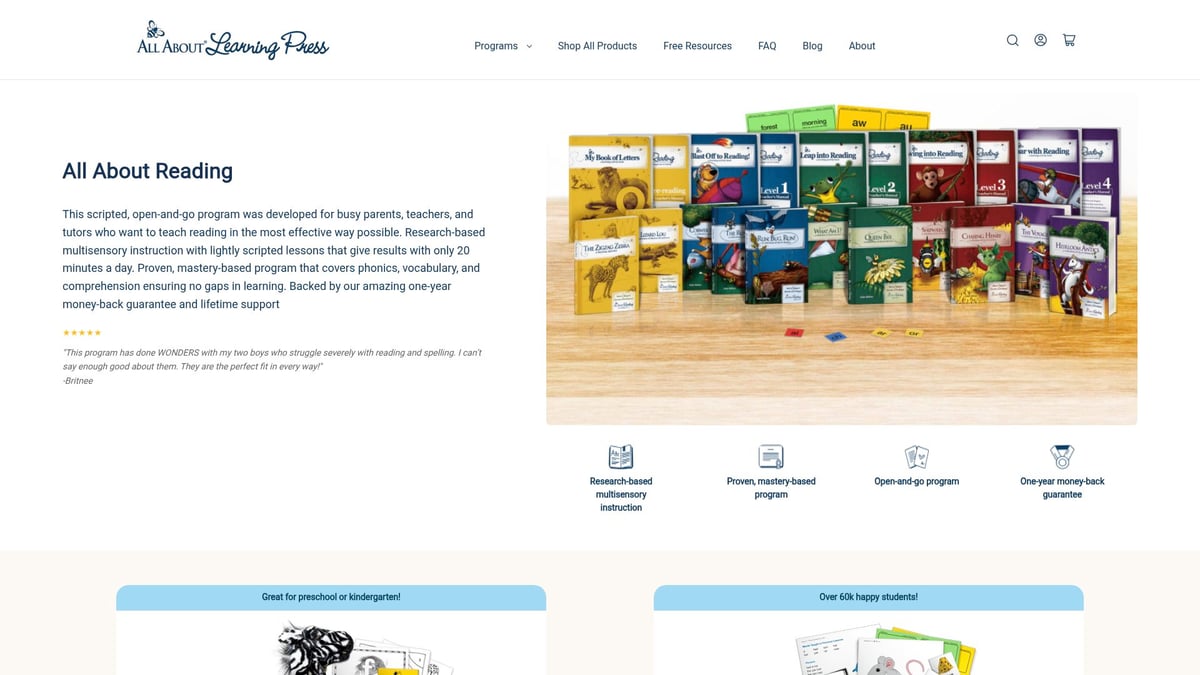
Pricing for complete level kits ranges from $150 to $200. The materials are reusable, making this reading curriculum homeschool investment cost-effective for families with multiple children.
Core features include interactive phonics lessons, hands-on activities, decodable readers, and fully scripted teacher’s guides. This structure is research-backed and particularly supportive for dyslexic learners.
Key benefits:
- Research-supported methodology
- Open-and-go design
- High parent satisfaction
Target audience:
- Pre-K through Grade 4
- Struggling readers
- Parents seeking multisensory methods
Pros:
- Strong support for various learning styles
- Step-by-step guidance for parents
- Materials can be reused
Cons:
- Higher upfront cost
- Some prep needed for activities
Many families highlight All About Reading as a game-changer in their reading curriculum homeschool journey, noting significant improvement in decoding and comprehension skills.
The Good and the Beautiful Language Arts
The Good and the Beautiful Language Arts offers a visually stunning and comprehensive reading curriculum homeschool solution. This program integrates phonics, literature, grammar, and art into a cohesive package.
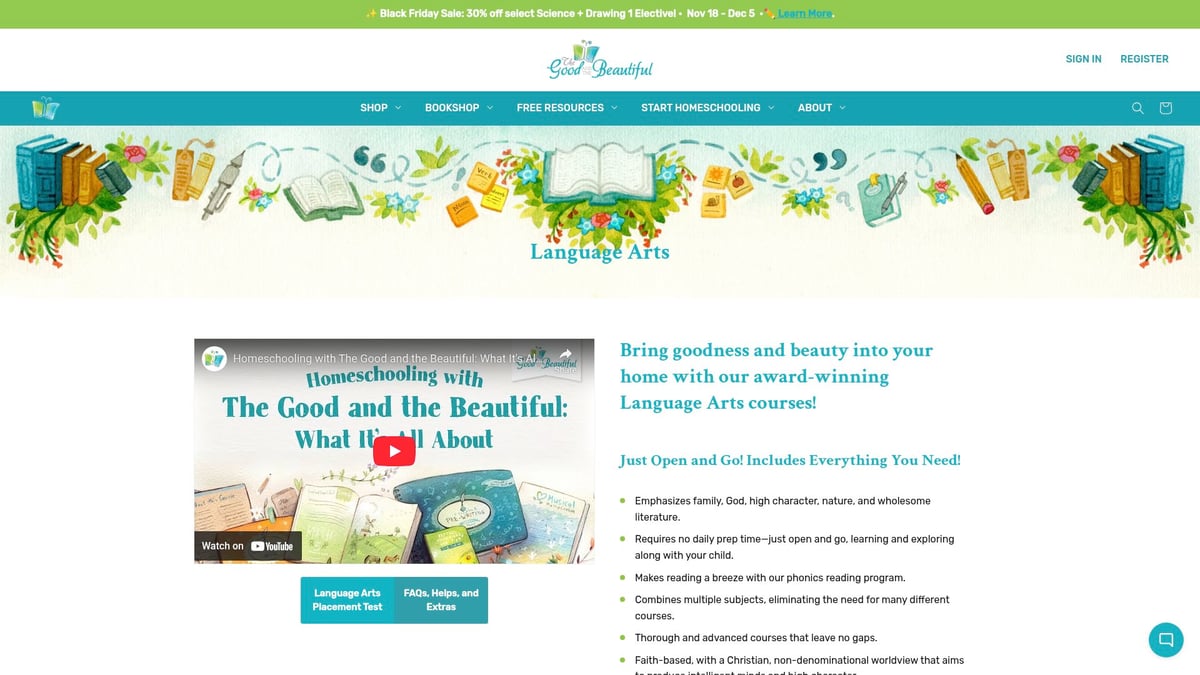
Families can download the curriculum for free as PDFs or purchase physical sets for $58 to $108 per level, making it accessible for a range of budgets. This flexibility allows homeschoolers to adapt the reading curriculum homeschool to their preferred format.
Core features include high-quality illustrations, open-and-go lessons, and faith-based content. The curriculum is designed to be minimal-prep, so parents can spend more time engaging with their children.
Key benefits:
- Covers multiple language arts subjects
- Visually engaging and beautifully designed
- Free digital option
Target audience:
- K–8th grade
- Families seeking a faith-based, all-in-one reading curriculum homeschool
Pros:
- Affordable or free
- Minimal prep required
- High aesthetic appeal
Cons:
- Religious content may not fit all families
- Some users find the pace slow for advanced readers
Parents consistently mention the program’s beautiful readers and ease of use as highlights, making it a popular reading curriculum homeschool choice for busy families.
Explode the Code
Explode the Code is a flexible and effective reading curriculum homeschool supplement, known for its sequential phonics workbooks and straightforward exercises. It’s suitable for both core instruction and targeted practice.
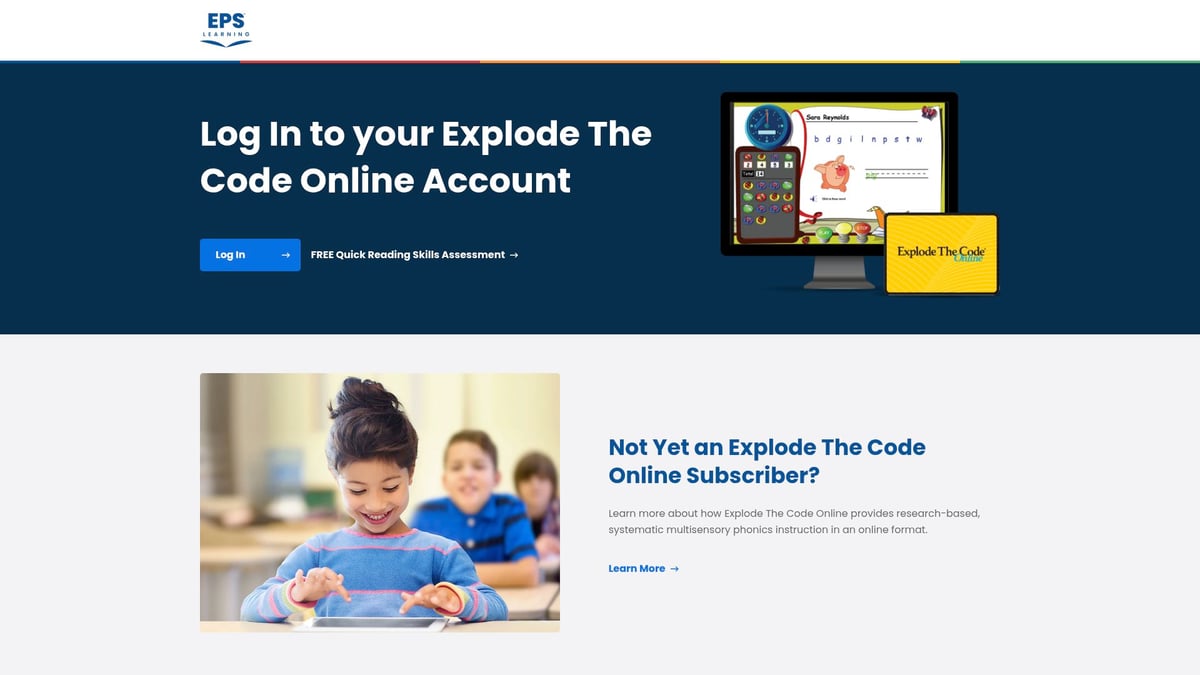
Workbooks are priced at about $12 to $15 each, with an online version available via subscription. This affordability makes it easy to integrate Explode the Code into any reading curriculum homeschool plan.
Core features include black-and-white, no-frills workbooks that focus on phonics mastery. An online companion provides interactive reinforcement, supporting different learning preferences.
Key benefits:
- Strong phonics foundation
- Independent work fosters self-motivation
- Proven, decades-long track record
Target audience:
- K–4th grade
- Children needing extra phonics practice
- Independent learners
Pros:
- Affordable and easy to find
- Flexible use as supplement or core
- Minimal parent involvement needed
Cons:
- No built-in readers
- Little teacher guidance
- Basic visuals
Many families pair Explode the Code with literature-based programs to create a more robust reading curriculum homeschool experience, especially for children who need extra decoding practice.
Multisori Montessori Reading Curriculum
Multisori Montessori Reading Curriculum brings the authentic Montessori method to the reading curriculum homeschool landscape. This digital curriculum is designed for global accessibility and ease of use, even for parents new to Montessori.
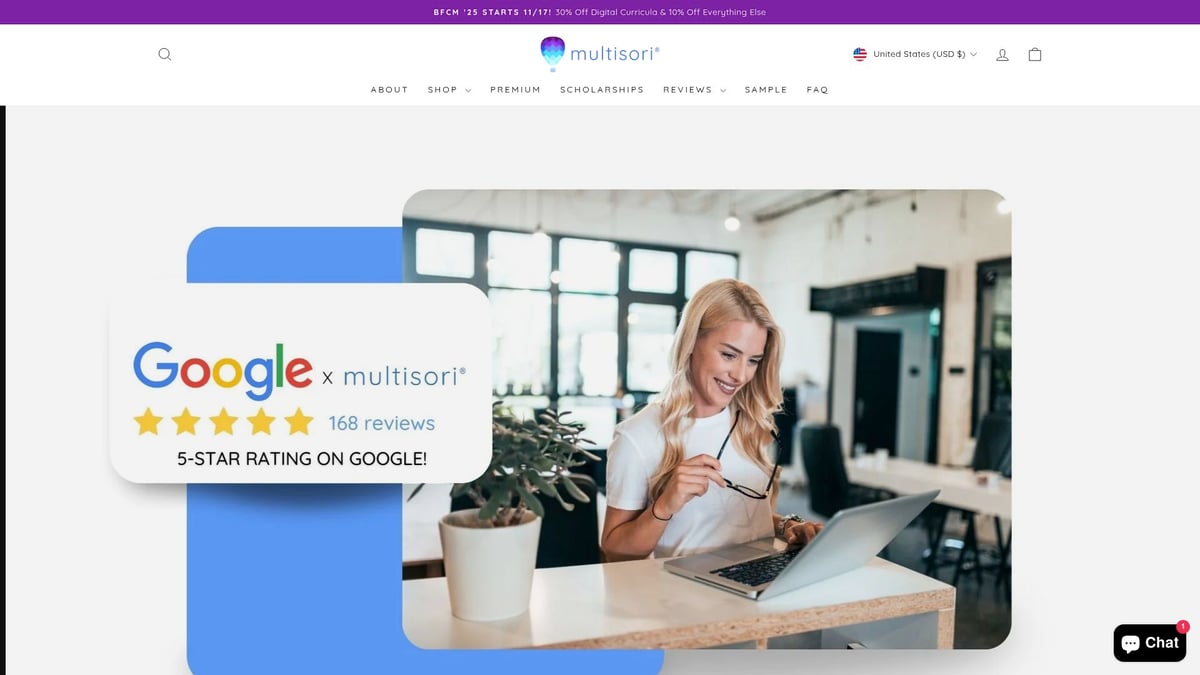
Pricing is flexible, with regular discounts (such as 30% off), payment plans, and scholarships. This ensures the reading curriculum homeschool is accessible to a wide range of families.
Core features include a true Montessori reading sequence, low-prep printable materials, and scripted presentations. Parents receive guidance on philosophy and ongoing expert support, making it a comprehensive choice.
Key benefits:
- No prior Montessori training needed
- Customizable for various homeschool or micro-school settings
- Includes consulting and certified Montessori furniture options
Target audience:
- Toddlers and primary-aged children
- Montessori homeschoolers, co-ops, and microschools
Pros:
- Comprehensive and easy to implement
- Global accessibility
- 5-star rated by users
Cons:
- Montessori approach may not fit all families
- Digital materials require printing
Parents frequently praise this Montessori homeschool reading curriculum for empowering them to deliver an authentic reading curriculum homeschool experience at home, even without prior training.
Logic of English Foundations
Logic of English Foundations is a systematic, multisensory program that excels in building a strong reading curriculum homeschool foundation. Its structured lessons emphasize phonemic awareness, handwriting, and spelling alongside reading.

Starter bundles cost between $80 and $120 per level, with reusable components that add value for families. This reading curriculum homeschool program is specifically designed to support children with dyslexia or language processing challenges.
Core features include explicit phonics instruction, interactive games, and clear teacher support. The curriculum is adaptable, allowing parents to adjust pacing as needed.
Key benefits:
- Evidence-based and systematic approach
- Engaging activities for young learners
- Supports struggling readers
Target audience:
- Ages 4–7
- Children with dyslexia or language processing issues
Pros:
- Strong focus on phonemic awareness
- Comprehensive teacher guidance
- Interactive, hands-on elements
Cons:
- Initial setup may feel overwhelming
- Higher cost for full sets
Families often report that Logic of English closes reading gaps and builds decoding skills, making it a reliable reading curriculum homeschool solution.
BookShark Reading with History
BookShark Reading with History combines a literature-rich approach with integrated history studies, providing a unique reading curriculum homeschool experience. Its packages start at about $300 and include literature, history, and instructor guides.
This program offers both secular and faith-based options, making it adaptable for diverse homeschool philosophies. The open-and-go format supports busy families while fostering a love of reading and history.
Core features include curated book lists, daily read-alouds, and guided discussion questions. While it emphasizes literature, phonics instruction is less prominent, so it often complements other reading curriculum homeschool options.
Key benefits:
- Rich, diverse literature selections
- Encourages family discussions
- Integrated approach to reading and history
Target audience:
- Grades K–8
- Families seeking literature-based, integrated learning
Pros:
- Comprehensive and engaging
- Supports family read-alouds
- Flexible for different educational philosophies
Cons:
- Higher price point
- Daily reading aloud required
- Less focus on phonics basics
Parents find BookShark especially effective for engaging reluctant readers, thanks to its captivating stories and interactive discussions.
Reading Eggs
Reading Eggs offers a gamified, online reading curriculum homeschool solution perfect for tech-savvy families and reluctant readers. Subscriptions start at $9.99 per month, with a free trial available for new users.
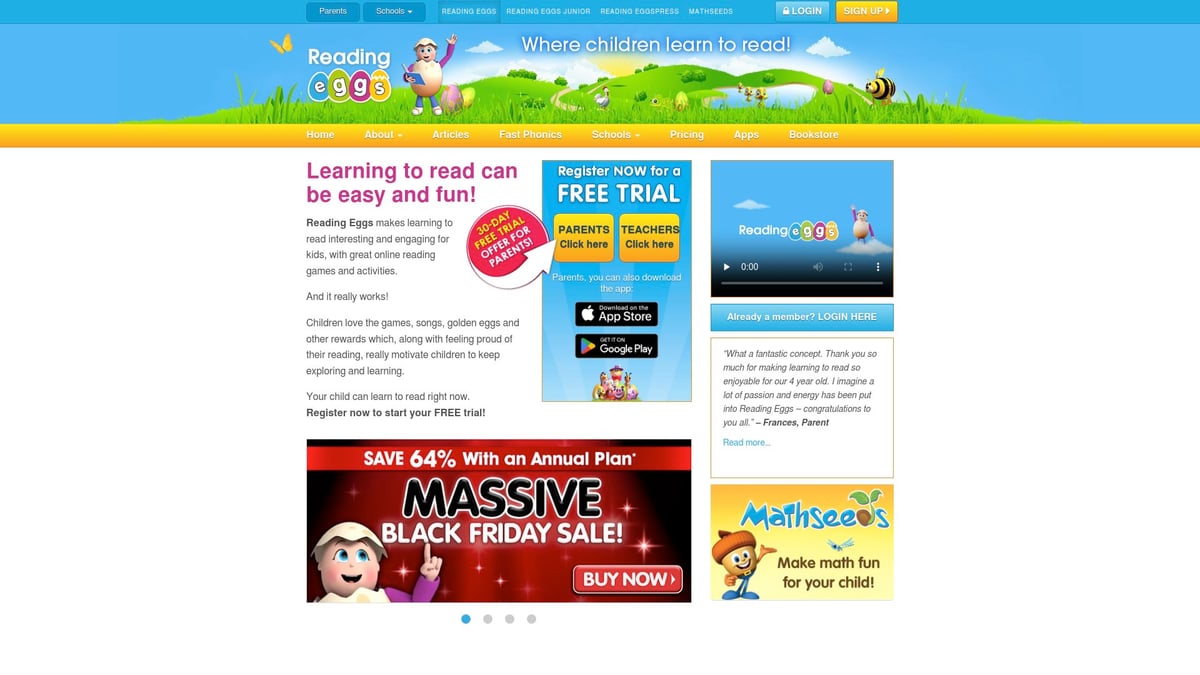
The platform features interactive phonics, comprehension, and spelling games that adapt to each child’s level. Progress tracking and instant feedback help parents stay informed about their child's journey in the reading curriculum homeschool environment.
Core features include engaging lessons, self-paced learning, and accessibility across devices. The curriculum is designed to motivate children through fun, game-like experiences.
Key benefits:
- Highly engaging and motivating
- Self-paced structure
- Detailed progress reports for parents
Target audience:
- Ages 3–13
- Families seeking digital, supplemental, or core reading curriculum homeschool options
Pros:
- Fun and interactive
- Easy for children to use independently
- Flexible for supplemental practice
Cons:
- Screen-based, may require parent moderation
- Ongoing subscription cost
Many families credit Reading Eggs for keeping their children motivated and transforming reading practice into an enjoyable part of their reading curriculum homeschool routine.
At-a-Glance Comparison Table
| Curriculum | Price Range | Format | Key Features | Ideal For |
|---|---|---|---|---|
| Primary Phonics | $5–$30+ | Sequential phonics, open-and-go | K–2, phonics remediation | |
| All About Reading | $150–$200 | Multisensory, scripted, reusable | Pre-K–4, dyslexia support | |
| The Good and the Beautiful | Free–$108 | Print/Digital | Integrated LA, faith-based, beautiful | K–8, faith-based families |
| Explode the Code | $12–$15 | Print/Online | Phonics workbooks, flexible | K–4, extra practice |
| Multisori Montessori | Varies | Digital | Montessori, consulting, global access | Toddlers–Primary, Montessori |
| Logic of English Foundations | $80–$120 | Systematic, games, handwriting | 4–7, struggling readers | |
| BookShark Reading with History | $300+ | Literature/history integration | K–8, literature lovers | |
| Reading Eggs | $9.99/mo | Online | Gamified, progress tracking | 3–13, tech-savvy families |
Each of these reading curriculum homeschool options brings unique strengths, ensuring every family can find a program that fits their needs and educational vision.
How to Choose the Best Reading Curriculum for Your Homeschool
Selecting the right reading curriculum homeschool solution is a pivotal decision for your family. With so many options available, understanding your child’s unique needs and your family’s priorities can make the process much smoother. Let’s break down the key steps to help you confidently choose an option that fits your homeschool journey.
Assessing Your Child’s Needs and Learning Style
Begin by identifying your child’s current reading level, strengths, and areas needing support. Consider whether your child thrives with hands-on, visual, auditory, or independent learning experiences, as this will shape your reading curriculum homeschool choice.
If your child has special needs, such as dyslexia or ADHD, seek curricula designed to address these challenges. Many programs offer placement tests or sample lessons, which are invaluable for making informed decisions. For example, you can access a Free Montessori curriculum sample to try before committing.
By matching a program to your child’s learning profile, you set the stage for reading success.
Matching Curriculum Features to Family Priorities
Think about what matters most to your family in a reading curriculum homeschool experience. Consider your budget, the time you can dedicate, and your preferred teaching style. Do you need a secular or faith-based approach? Would you rather use print materials or digital resources?
Some families prefer open-and-go curricula for simplicity, while others enjoy more parent-led or scripted lessons. Evaluate how each program aligns with your technology access and teaching preferences. For instance, programs like The Good and the Beautiful offer both digital and print options, catering to different needs.
Taking stock of these priorities helps you filter out options that are not a good fit.
Planning for Multiple Ages and Long-Term Use
If you’re teaching more than one child, look for a reading curriculum homeschool solution that adapts across multiple grade levels. Curricula with reusable components or flexible levels allow you to use the same resources for siblings or as your child advances.
Consider whether you’ll need to purchase supplements or additional readers as your children grow. Programs like All About Reading and BookShark are known for their adaptability and long-term value, making them strong choices for families with varied ages.
Thinking ahead helps you maximize your investment and minimize future hassle.
Leveraging Support, Community, and Flexibility
Support and community are essential for a successful reading curriculum homeschool experience. Seek out programs that provide access to online forums, responsive customer service, and training resources.
Joining homeschool communities can help you troubleshoot challenges and share ideas. Some curricula, such as Multisori, include ongoing consulting and expert support. Real-world feedback, like the stories found in homeschool curriculum parent testimonials, can offer reassurance and practical tips.
Flexibility in pacing and teaching support ensures your curriculum adapts with your family’s needs.
Budgeting and Sourcing Materials
Carefully compare total costs, including shipping, consumable workbooks, and potential add-ons. Look for bundle deals, free trials, or the option to buy used materials to keep your reading curriculum homeschool budget-friendly.
Many publishers offer free samples or trial periods, allowing you to evaluate fit before making a purchase. Planning for future years—such as purchasing reusable sets—can also help you stretch your investment further.
With thoughtful budgeting and resource planning, you can provide a high-quality reading experience for your homeschool.
Frequently Asked Questions About Homeschool Reading Curricula
Choosing the right reading curriculum homeschool solution sparks plenty of questions for new and experienced families alike. Below, we address some of the most common concerns to help you find clarity, confidence, and the best fit for your child’s education.
What’s the difference between phonics-based and sight-word curricula?
Phonics-based reading curriculum homeschool programs teach children how to decode words using letter sounds, building a strong foundation for lifelong reading. In contrast, sight-word approaches focus on memorizing whole words, which may not promote deep comprehension or fluency. According to the Right to Read Inquiry Report, systematic phonics instruction is now widely recommended by experts for its proven results.
How much time should I spend on reading instruction daily?
Most reading curriculum homeschool recommendations suggest dedicating 15 to 30 minutes each day for young learners. This time frame helps maintain focus and allows lessons to be adjusted to your child’s pace and attention span. Open-and-go programs can reduce preparation time, making it easier to fit consistent reading into your daily schedule.
Can I combine multiple reading programs?
Many families blend a core reading curriculum homeschool program with supplemental resources, such as additional readers or educational apps. For example, Explode the Code is frequently paired with literature-based curricula to reinforce decoding skills. Just ensure that the methods and philosophies are compatible to avoid confusing your learner.
Are there reading curricula for children with dyslexia or learning differences?
Yes, several reading curriculum homeschool options are designed for students with dyslexia or other learning challenges. All About Reading, Logic of English, and Reading Eggs provide multisensory, explicit instruction that supports struggling readers. Look for programs with positive testimonials and evidence of success in diverse learning situations.
Where can I find reviews or try before I buy?
Most publishers offer free samples, placement tests, or trial periods for their reading curriculum homeschool products. You can also explore homeschool forums and Facebook groups to read real-world feedback from other families. Additionally, resources like Homeschooling Research Facts provide valuable insights and data to guide your decision.
As you consider the best way to nurture your child’s reading journey in 2025, it helps to see firsthand what a thoughtfully designed curriculum can offer. You deserve resources that are not only engaging and effective but also flexible and supportive—just like the options we explored together. If you’re curious about how a Montessori approach could enrich your homeschool, why not take a closer look? You can explore authentic, expertly crafted materials and discover how easy it is to bring joy and confidence to your child’s reading experience.
Download our Free Curriculum Sample Now




